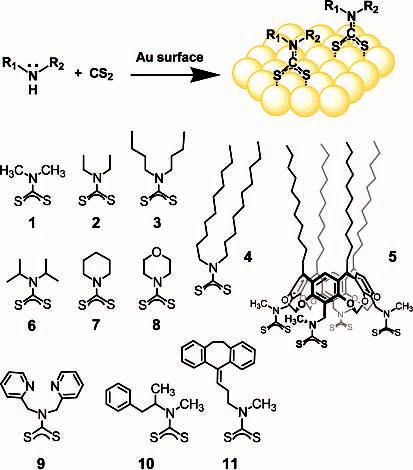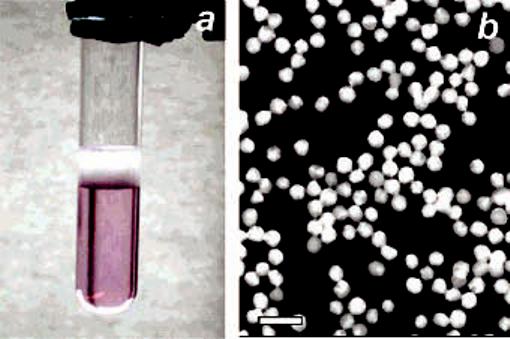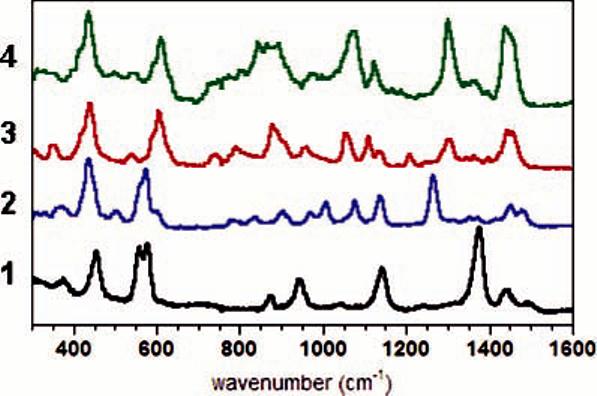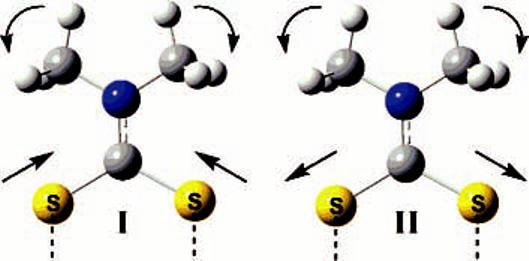The functionalization of metal substrates with organic ligands has become a standard practice in surface science and nanomaterials chemistry. Perhaps the most prevalent example is the chemisorption of thiols on Au, a simple yet versatile approach for preparing surfaces with tunable physical or chemical properties1,2 or with biological recognition elements.3-5 While such chemistry has proven to be very useful for a multitude of applications, it also has limitations; thiols can be displaced from the metal surface6 or may be incompatible with other functional groups associated with the ligand. Molecules with carbodithioate (−CS2) groups may have superior chemisorption properties, as their interatomic S–S distances are nearly ideal for epitaxial adsorption onto Au surfaces.7 Such ligands would be attractive alternatives to thiols if issues of accessibility and robustness of adsorption can be addressed.
In this Communication, we describe the spontaneous assembly of dithiocarbamate (DTC) ligands on Au surfaces, by simple exposure to carbon disulfide and secondary amine (see Figure 1). DTCs are considered unstable in their acidic form and are often prepared as metal salts by the condensation of dialkylamines with CS2 under strongly basic conditions.8 More recently, DTCs have been applied as structural motifs in supramolecular chemistry when complexed with transition metal ions.9,10 Here, we show that a variety of secondary amines can condense with CS2 onto Au surfaces at room temperature without additional base to form ligands which are stable in acidic and basic aqueous environments and in the presence of competing surfactants.
Figure 1.

Dithiocarbamate ligands formed on Au surfaces.
Dithiocarbamate ligands 1–11 were readily formed by immersing Au substrates in solutions with an equimolar ratio of CS2 and the corresponding amines (see Figure 1).11,12 This one-pot procedure could be performed in either aqueous or organic solvents, but was found to be most efficient in alcohols. Contact angle measurements of DTC-functionalized Au surfaces revealed marked changes in their wetting properties; smooth Au substrates coated with dimethyl DTC 1 (θav = 60°) were more hydrophilic than bare Au (θav = 80°), whereas those coated with dibutyl and didecyl DTCs 3 and 4 were more hydrophobic (θav = 107 and 108°, respectively). By comparison, substrates treated with dialkylamines in the absence of CS2 did not exhibit significant changes in wetting behavior after rinsing.11
Dithiocarbamates could also assemble on colloidal Au nano-particles and modulate their dispersion properties. For example, aqueous suspensions of 40 nm Au particles treated with CS2 and tetra(N-methyl)aminomethyl resorcinarene (TMAR)11,13 at millimolar concentrations were encapsulated by DTC ligand 5 and could be subsequently extracted from the aqueous phase into CH2Cl2 (see Figure 2). No extractions occurred in the absence of CS2 or TMAR, demonstrating that phase transfer was successful only when the nanoparticles were encapsulated by the DTC–resorcinarene surfactant layer.14
Figure 2.

(a) Extraction of colloidal Au nanoparticles (d = 40 nm) from the aqueous phase into CH2Cl2 by dithiocarbamate derivative 5, formed in situ from CS2 and TMAR. (b) TEM image (Philips EM-400, 80 kV) of extracted Au nanoparticles; scale bar = 100 nm.
Dithiocarbamate assembly on roughened Au substrates15 was further characterized using surface-enhanced Raman spectroscopy (SERS; see Figure 3 and Supporting Information). In the case of DTC ligands 1–4, the SERS spectra were found to be nearly identical with those generated from preformed DTC salts, providing confirmation of structure.11,16 Vibrational modes were assigned according to density functional theory (DFT) calculations. Raman frequencies were calculated for ligands 1 and 2 bonded to a Au cluster (1–3 atoms) using the B3LYP method and LANL2DZ basis set. The calculated values correlate well with the experimental SERS data, most notably for peak frequencies at 430–450 cm−1 (I) and 540–600 cm−1 (II). These vibrational bands correspond with symmetrically coupled C-S stretching and N-alkyl bending (scissoring) modes of the DTC moiety anchored to the metal surface (see Figure 4). The SERS bands at 1450–1475 cm−1 associated with C–H bending modes are also noteworthy and increase in prominence with hydrocarbon chain length.17
Figure 3.

Selected SERS spectra of dialkyl DTCs formed on roughened Au surfaces. Spectra were obtained using a dispersive Raman microscope with a 20X objective lens (N.A. = 0.4), at an excitation wavelength of 785 nm and an exposure time of 30 s. See Supporting Information for additional SERS spectra.
Figure 4.

Coupled C–S stretching/N-alkyl scissoring modes for dithiocarbamates on Au, based on DFT calculations (B3LYP/LANL2DZ).11 (Left) Mode I (1: calcd 436 cm−1; 2: 443 cm−1); (right) mode II (1: calcd 562 cm−1; 2: 543 cm−1). See Supporting Information for movies of vibrational modes I and II.
The dithiocarbamate ligands are remarkably robust in a variety of solution environments and are resistant to displacement by competing alkanethiols. Roughened Au substrates functionalized with ligands 1 or 2 were exposed to aqueous solutions ranging from pH 1 to 12 and monitored by SERS, which revealed minimal changes in the spectral profile after 1 week of immersion at ambient temperature. The DTC-coated substrates were likewise immersed for 1 week in ethanolic solutions of dodecanethiol, again with minimal perturbations to their SERS spectra.
Surface analysis by contact angle goniometry and X-ray photoelectron spectroscopy (XPS) provided further evidence for robust DTC chemisorption. For example, a substrate saturated with dibutyl DTC 3 was exposed to a millimolar solution of 2-mercaptoethanol for 24 h, a condition known to completely displace alkanethiol monolayers.18 Minimal change in contact angle was observed (Δθav < 3°), and the S:N mole ratio remained constant at 2.14:1.11 The limits of thermal stability under aqueous conditions were also examined, with a decrease in contact angle finally observed after 12 h at 85 °C.
In summary, dithiocarbamate formation provides a simple method for conjugating secondary amines onto metal surfaces to form strongly adsorbed species which are stable under various types of environmental stress. The robustness of the DTC ligands and the ease with which they can be formed should expand the range of synthetic or biomolecular structures for applications involving surface or nanoparticle functionalization.
Supplementary Material
Acknowledgment
This work was supported by the National Science Foundation (CHE-0243496, ECS-0210445) and the National Institutes of Health (EB-001777-01, GM-06982-01). W.P.S. acknowledges the GEM fellowship program for a predoctoral fellowship. XPS spectra were provided by Ms. Bo Gao and Prof. Marya Lieberman at the University of Notre Dame. The authors also gratefully acknowledge Mr. John Howarth and Prof. Jeffrey Youngblood for the use of their goniometer, and Dr. Ren-Hua Fan and Prof. Eric Barker for providing the amines for DTC ligands 9–11.
Footnotes
Supporting Information Available: Experimental procedures, XPS data, contact angle measurements, additional SERS spectra, and calculated Raman spectra of 1 and 2 on Au (PDF); movies of vibrational modes I and II calculated for 1 and 2 on Au3 (MPEG). This material is available free of charge via the Internet at http://pubs.acs.org.
References
- 1.(a) Pale-Grosdemange C, Simon ES, Prime KL, Whitesides GM. J. Am. Chem. Soc. 1991;113:12–20. [Google Scholar]; (b) Dubois LH, Nuzzo RG. Annu. Rev. Phys. Chem. 1992;43:437–463. [Google Scholar]
- 2.Templeton AC, Wuelfing MP, Murray RW. Acc. Chem. Res. 2000;33:27–36. doi: 10.1021/ar9602664. [DOI] [PubMed] [Google Scholar]
- 3.(a) Mirkin CA, Letsinger RL, Mucic RC, Storhoff JJ. Science. 1996;382:607–609. doi: 10.1038/382607a0. Nucleic acids: [DOI] [PubMed] [Google Scholar]; (b) Alivisatos AP, Johnsson KP, Peng X, Wilson TE, Loweth CJ, Bruchez MP, Jr., Schultz PG. Nature. 1996;382:609–611. doi: 10.1038/382609a0. [DOI] [PubMed] [Google Scholar]; (c) He L, Musick MD, Nicewarner SR, Salinas FG, Benkovic SJ, Natan MJ, Keating CD. J. Am. Chem. Soc. 2000;122:9071–9077. [Google Scholar]
- 4.(a) Sun X, Sheardown H, Tengvall P, Brash JL. J. Biomed. Mater. Res. 1999;49:66–78. doi: 10.1002/(sici)1097-4636(200001)49:1<66::aid-jbm9>3.0.co;2-x. Peptides: [DOI] [PubMed] [Google Scholar]; (b) Strong AE, Moore BD. J. Mater. Chem. 1999;9:1097–1105. [Google Scholar]; (c) Tkachenko AG, Xie H, Coleman D, Glomm W, Ryan J, Anderson MF, Franzen S, Feldheim DL. J. Am. Chem. Soc. 2003;125:4700–4701. doi: 10.1021/ja0296935. [DOI] [PubMed] [Google Scholar]; (d) Pengo P, Broxterman QB, Kaptein B, Pasquato L, Scrimin P. Langmuir. 2003;19:2521–2524. [Google Scholar]
- 5.(a) Fritz MC, Hähner G, Spencer ND, Bürli R, Vasella A. Langmuir. 1996;12:6074–6082. Carbohydrates: [Google Scholar]; (b) de la Fuente J, Barrientos AG, Rojas TC, Rojo J, Cañada J, Fernández A, Penadés S. Angew. Chem., Int. Ed. 2001;40:2258–2261. [PubMed] [Google Scholar]; (c) Otsuka H, Akiyama Y, Nagasaki Y, Kataoka K. J. Am. Chem. Soc. 2001;123:8226–8230. doi: 10.1021/ja010437m. [DOI] [PubMed] [Google Scholar]; (d) Houseman BT, Mrksich M. Top. Curr. Chem. 2002;218:1–44. [Google Scholar]; (e) Smith EA, Thomas WD, Kiessling LL, Corn RM. J. Am. Chem. Soc. 2003;125:6140–6148. doi: 10.1021/ja034165u. [DOI] [PubMed] [Google Scholar]
- 6.(a) Schlenoff JB, Li M, Ly H. J. Am. Chem. Soc. 1995;117:12528–12536. [Google Scholar]; (b) Flynn NT, Tran TN, Cima MJ, Langer R. Langmuir. 2003;19:10909–10915. [Google Scholar]
- 7.(a) Ulman A. Chem. Rev. 1996;96:1533–1554. doi: 10.1021/cr9502357. [DOI] [PubMed] [Google Scholar]; (b) Colorado R, Jr., Villazana RJ, Lee TR. Langmuir. 1998;14:6337–6340. [Google Scholar]; (c) Querner C, Reiss P, Bleuse J, Pron A. J. Am. Chem. Soc. 2004;126:11574–11582. doi: 10.1021/ja047882c. [DOI] [PubMed] [Google Scholar]
- 8.(a) Coucouvanis D. Prog. Inorg. Chem. 1970;11:233–371. [Google Scholar]; (b) Arndt T, Schupp H, Schrepp W. Thin Solid Films. 1989;178:319–326. [Google Scholar]
- 9.McCubbin QJ, Stoddart FJ, Welton T, White AJP, Williams DJ. Inorg. Chem. 1998;37:3753–3758. doi: 10.1021/ic980067b. [DOI] [PubMed] [Google Scholar]
- 10.(a) Fox OD, Drew MGB, Beer PD. Angew. Chem., Int. Ed. 2000;39:136–140. doi: 10.1002/(sici)1521-3773(20000103)39:1<135::aid-anie135>3.0.co;2-n. [DOI] [PubMed] [Google Scholar]; (b) Berry NG, Pratt MD, Fox OD, Beer PD. Supramol. Chem. 2001;13:677–682. [Google Scholar]; (c) Beer PD, Berry N, Drew MGB, Fox OD, Padilla-Tosta ME, Patell S. Chem. Commun. 2001:199–200. [Google Scholar]; (d) Beer PD, Berry NG, Cowley AR, Hayes EJ, Oates EC, Wong WH. Chem. Commun. 2003:2408–2409. doi: 10.1039/b308629a. [DOI] [PubMed] [Google Scholar]
- 11. See Supporting Information for details.
- 12. Dithiocarbamates could also be prepared by the sequential exposure of substrates to neat CS2 followed by immersion in amine solutions; however, the rapid vaporization of CS2 limited the reliability of this approach.
- 13.Boerrigter H, Verboom W, Reinhoudt DN. J. Org. Chem. 1997;62:7148–7155. doi: 10.1021/jo9703414. [DOI] [PubMed] [Google Scholar]
- 14.(a) Balasubramanian R, Kim B, Tripp SL, Wang X, Lieberman M, Wei A. Langmuir. 2002;18:3676–3681. [Google Scholar]; (b) Kim B, Balasubramanian R, Pérez-Segarra W, Wei A, Decker B, Mattay J. Supramol. Chem. 2005;17:173–180. [Google Scholar]
- 15.Gao P, Gosztola D, Leung L-WH, Weaver MJ. J. Electroanal. Chem. 1987;233:211–222. Au substrates were electrochemically roughened using the oxidation–reduction protocol described by Weaver et al. [Google Scholar]
- 16.(a) Sánchez-Cortés S, Vasina M, Francisco O, García-Ramos JV. Vib. Spectrosc. 1998;17:133–144. [Google Scholar]; (b) Sánchez-Cortés S, Domingo C, García-Ramos JV, Aznárez JA. Langmuir. 2001;17:1157–1162. doi: 10.1021/la001269z. [DOI] [PubMed] [Google Scholar]
- 17. The DTC ligands may adopt another mode of bonding to the Au surface, giving rise to split peaks such as that observed for 1. Further discussion on the vibrational modes of adsorbed DTC ligands will be reported elsewhere.
- 18.(a) Demers LM, Mirkin CA, Mucic RC, Reynolds RA, Letsinger RL, Elghanian R, Viswanadham G. Anal. Chem. 2000;72:5535–5541. doi: 10.1021/ac0006627. [DOI] [PubMed] [Google Scholar]; (b) Castelino K, Kannan B, Majumdar A. Langmuir. 2005;21:1956–1961. doi: 10.1021/la047943k. [DOI] [PubMed] [Google Scholar]
Associated Data
This section collects any data citations, data availability statements, or supplementary materials included in this article.


